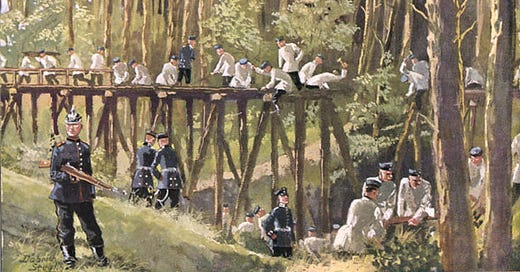In peacetime, each pioneer battalion of the German armies consisted of four companies. Upon mobilization, the peacetime battalion filled the ranks of its four peacetime companies, thereby converting them into “active” pioneer companies. At the same time, it formed two reserve pioneer companies and the headquarters of two wartime pioneer battalions.[1]
In the case of ordinary pioneer battalions, the first of the wartime battalions, made up of three active companies, reported for duty with an active army corps. The commanding general of that formation then assigned the pioneer companies to the infantry divisions of his corps, giving two pioneer companies to one division while allocating the remaining pioneer company to the second division of the corps. (Strange to say, the German authorities preferred this lopsided arrangement to the more elegant solution, adopted by the French Army of the time, of giving one company of engineers to each infantry division and keeping the third in general support of the army corps.)
The second wartime battalion, made up of one active company and two reserve companies, might be assigned to one of the reserve army corps assembled upon mobilization. Alternatively, it might find employment as part of the garrison of a fortress.[2]
Also known as “field battalions,” the first and second wartime battalions formed by each peacetime pioneer battalion bore the name of its parent unit preceded by a Roman numeral. Thus, the 10th Pioneer Battalion mobilized I/10 Pionier Bataillon and II/10 Pionier Bataillon.
Notes:
Bavarian Army used a different method to convert its three ordinary peacetime pioneer battalions into wartime field battalions. Upon mobilization, each of the peacetime battalions formed four wartime companies, three of which remained with its parent unit and one of which joined the new field battalion of the Bavarian Reserve Corps. Bayerischen Kriegsarchiv, Die Schlacht in Lothringen und in den Vogesen 1914 (Munich: M. Schick, 1929) Volume 1, pages 23 and 24.
Information about the allocation of field pioneer battalions to reserve army corps and fortresses comes from the organizational appendices to the first two volumes of the German official history, Der Weltkrieg, 1914-1918.







